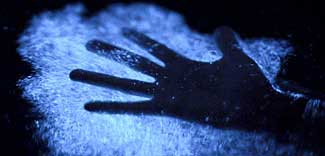| |
|
| |
 |
|
Sparks below. Muted fire above.
I have experienced bioluminescence before...swimming off the west coast of Florida years ago and, also decades ago, here in Puerto Rico. But never like this. An engulfing world of living, glowing blue-green.
We were kayaking just off Vieques, an island off the Puerto Rico mainland. It was a moonless night...absolutely perfect for the fire show nature was putting on. |
|
| |
Kayaking in bioluminiscence in Fajardo’s Bio Bay off Vieques, Puerto Rico.
Courtesy Discover Puerto Rico |
|
|
|
The boats we used are billed as kayaks but they’re closer to canoes...except you sit flush with the water and ours all had see-through bottoms.
| |
As we skimmed over the water, the bioluminescence shot below us in streams of sparks. Then, when I dipped my hand in the water and spread my fingers, each finger glowed, leaving a trail of blue green fire in its wake. And above, was the Milky Way…much, much brighter than anything I can see at my rural home outside Seattle.
And way, way better than anything I remember from so long ago. |
|
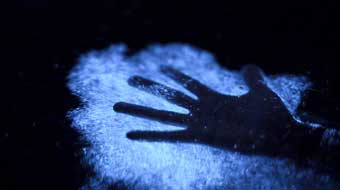 |
|
| |
|
|
Hand surrounded by the glow of bioluminiscence |
|
It turns out, Mosquito Bay where we kayaked, is probably the brightest bioluminescent bay in the world. So said Guinness World Records in 2006.
From their website: “Mosquito Bay on the island of Vieques in Puerto Rico, USA, contains up to 700,000 tiny dinoflagellates per gallon of water. When agitated, these microscopic organisms react by flashing a blue-green light for about one-tenth of a second. The island boasts other bioluminescent bays, but Mosquito Bay is the brightest—its narrow mouth prevents the dinoflagellates from being washed out to sea, and decaying mangrove swamps provide them with plentiful food.”
The hyperactive little female critters, it turns out, are eagerly trying to attract the boys. Yup, it’s all about sex.
Our entire paddling adventure lasted about an hour...enough time to see stuff, not so long that we got wiped out from the effort.
| |
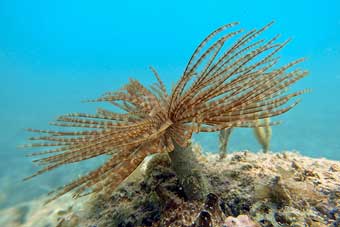 |
|
 |
|
| |
Tube worm in shallow water off Vieques, Puerto Rico. Also called magnificant featherduster. Photo by Sarah Elise P. Field |
|
Sea pearl - a type of green but also other kinds of algae. Photo by Sarah Elise P. Field
|
|
Another group got to swim in the bioluminescence. But, it turns out, doing this pollutes the water. Body oils, left-over sun screen and such. This has affected the brilliance of what’s going on in the water. So visiting by kayak is probably the most spectacular way to experience this phenomenon.
Water, whether you’re on or in it, is really the way to go when visiting Vieques. While the air temperature during my visit was 85 degrees, thanks to humidity, it felt (according to my app) like 95. Coming from MUCH cooler Seattle, the heat/humidity nearly did me in. But spending time on or under water solved the heat problem for me.
So in addition to the kayaking, both by day and night, my group snorkeled and took a ride on four-person Zodiac-like boats.
| |
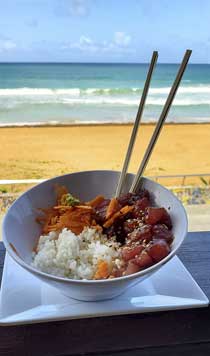 |
|
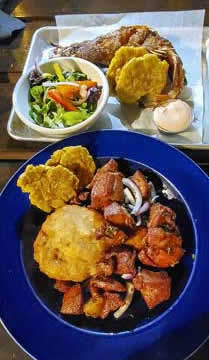 |
|
| |
Sashimi bowl with raw tuna, rice and carrots at a beachside cafe in San Juan, Puerto Rico
|
|
Dinner at El Plaza on Vieques. Fried plantains (related to bananas but starchier) and chunks of pork. Fried local fish in background |
|
And while you can rent a car and stop at any number of beaches to swim, it was even better for us doing that with someone who could explain what we were seeing.
Sarah Elise P. Field of Crystal Clear Vieques was our guide this day. She explained first off that when we got into shallow water, we should only stand on sand...not on rock that might actually be living coral.
The visibility here for snorkeling can often be 40 feet or more. But this day, it was half that because storms off-shore were stirring up sediment. Even so, we were in hardly 15 feet of water, so we saw everything with no trouble.
Down below was a turtle making its way ever so slowly along the bottom. A dozen grunts–bright tropical fish with yellow on top and silver on the bottom–swam in front of us in a school. A skinny blue file fish floated nearby. A stingray sat almost completely covered by sand. And everywhere were colorful sponges. It was like swimming in an aquarium.
Back on the beach, Sarah Elise explained why she lives in Puerto Rico and especially in Vieques. She loves the culture…more family oriented and not so much work-competition oriented was the way she put it.
| |
And a funny thing about Puerto Rico/Vieques. “Everybody here says ‘Back in the States.’ Uh...Puerto Rico IS the States. But not exactly. It’s not a possession, but it’s also not officially a state. Basically, it’s considered an unincorporated territory of the US - somewhat, truthfully, in political limbo.
And yes, the pace of life is also different...decidedly slower and more casual. So in the end, we had to slow down and just enjoy the moment...the sun, the warmth, the peace.
Locals suggest that a three day stay in Vieques works well. One day to orient yourself and recover from the trip to get there. One day for the beaches and bio-bay experience that night. One day to take a guided tour of the island.
And don’t worry about visiting during the “low season” of late summer/early fall. Spend time in the water to deal with the heat/humidity. And remember that the Caribbean covers a million square miles of ocean, so just because there might be a storm affecting islands near South America, that doesn’t mean all the islands will be affected. |
|
 |
|
| |
|
|
Early morning on Vieques, an island offshore from Puerto Rico |
|
Meanwhile, as for the myth that you shouldn’t travel to Puerto Rico during hurricane season (basically September)…hurricanes usually bypass the islands, perhaps stirring up the water but not much more. Finally… every Caribbean island isn’t ringed by beaches. The “Caribbean” also includes Mexico and the east coast of Central America.
Contact:
Black Beard Sports, www.blackbeardsports.com, 939-283-6841
Crystal Clear Vieques, www.crystalclearvieques.com, 787-242-1071
| |
|
 |
|
|
| |
|
400-year-old ceiba tree, also known as silk cotton or kapoc tree. This tree on on Vieques, an island off Puerto Rico, is believed to have been the inspiration for the tree of souls in the Avatar movie. |
|
|
ABOUT THE AUTHOR
| |
Yvette Cardozo is a writer/photographer who loves adventure and the outdoors, specifically skiing, scuba diving and cycling. If it involves interesting food (ethnic delicacies, high arctic "country food," molecular gastronomy and whatever else is interesting or weird), so much the better. She has skied in Kashmir, India, scuba dived both the Arctic and Antarctic, run a dogsled team above the arctic circle and more. She is a member of SATW (Society of American Travel Writers) and NASJA (North American Snowsports Journalists Association). Her stories appear in the Chicago Tribune, NY Post, Miami Herald, Dallas Morning News, among other newspapers, along with Just For Canadian Doctors, Sport Diver and several international magazines. |
|
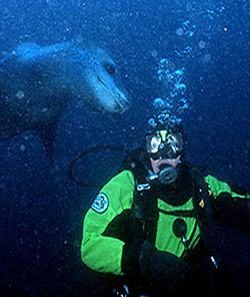 |
|
|
|
|
